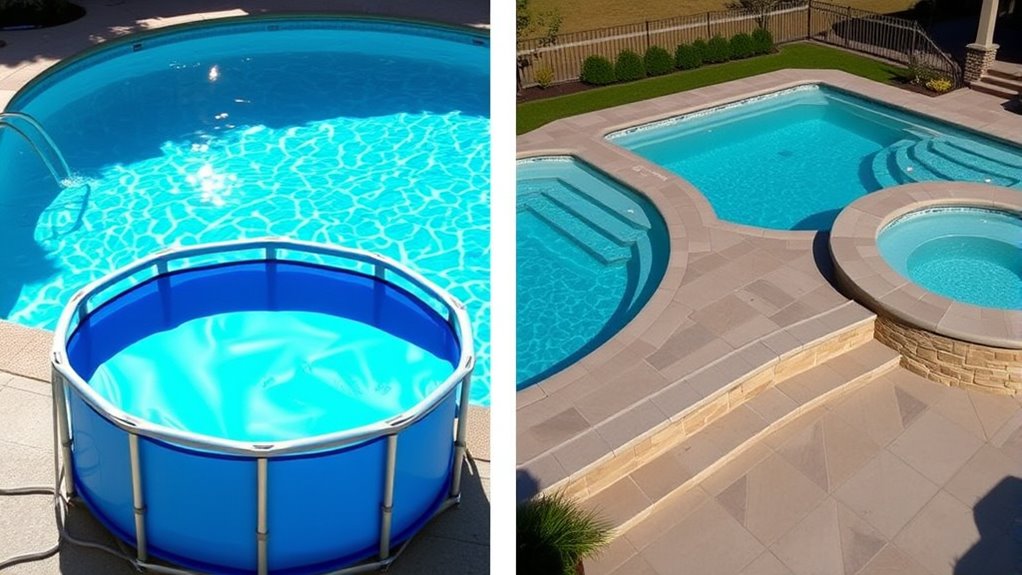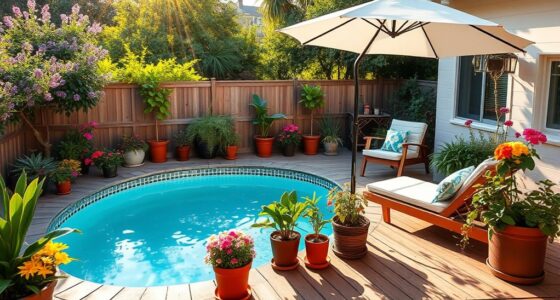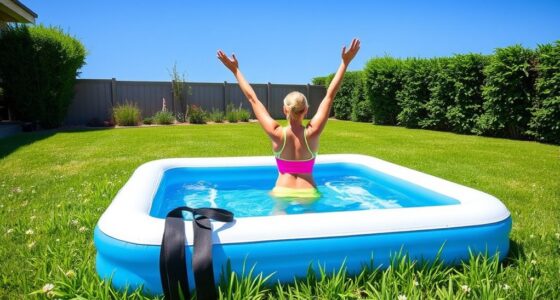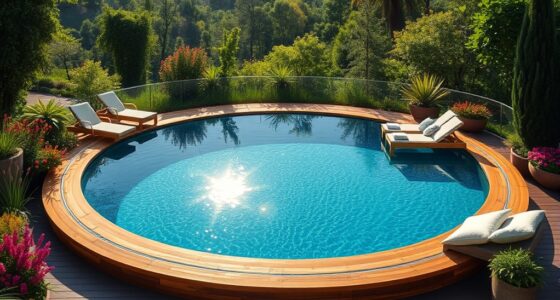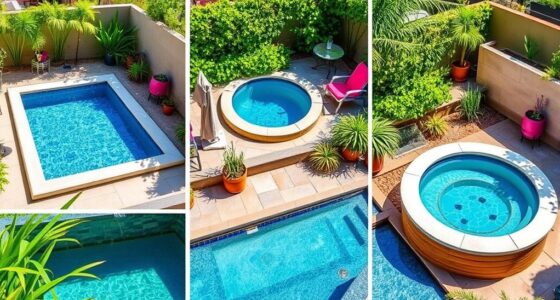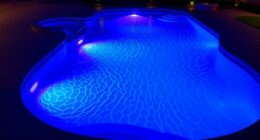When comparing small pools to standard ones, you’ll find small pools cost a few thousand dollars upfront and have lower ongoing expenses for maintenance and accessories. Standard pools, however, require a larger initial investment and come with higher long-term costs, from chemicals to upkeep. Your budget and how much maintenance you’re willing to do matter a lot. To better understand which option fits your financial plan, keep exploring the details ahead.
Key Takeaways
- Small pools have lower initial purchase prices, often a few thousand dollars, compared to tens of thousands for standard-sized pools.
- Maintenance costs for small pools are generally lower due to less chemical use, simpler filtration, and reduced cleaning time.
- Accessories for small pools are simpler and less expensive, while standard pools may require costly advanced equipment and features.
- Larger pools tend to last longer and maintain value better, but involve higher ongoing maintenance expenses.
- Overall, small pools are more budget-friendly upfront and easier to maintain, whereas standard pools demand a bigger initial investment and higher long-term costs.

Adding a pool to your backyard can be an exciting upgrade, but understanding the costs involved is vital before making a decision. When comparing small pools to standard-sized ones, you’ll find that initial purchase prices are only part of the story. Small pools typically cost less upfront, which makes them appealing if you’re working within a tighter budget. You might find a compact above-ground pool for a few thousand dollars, while a larger, custom in-ground pool can easily run into tens of thousands. But don’t forget, the real expenses come later, especially when considering ongoing costs like pool maintenance and accessories.
Pool maintenance is a key factor influencing your overall budget. Smaller pools generally require less chemical treatment, fewer filtration cycles, and less time spent on cleaning, which can save you money and effort. They also tend to have lower energy costs because their pumps and filtration systems consume less power. In contrast, standard pools demand more frequent maintenance, higher chemical usage, and more powerful equipment to keep the water clear and safe. These ongoing costs can add up quickly, making the initial savings less meaningful over time.
Pool accessories also play a big role in your total expenditure. For small pools, you might only need basic accessories such as a simple cover, a small pump, and minimal lighting. These items are usually less expensive and easier to install. A standard pool, however, often calls for a wider range of accessories—such as advanced cleaning systems, underwater lighting, heaters, and elaborate safety features. All these extras enhance your swimming experience but can greatly increase your overall costs.
Another aspect to consider is the longevity and durability of your pool investment. Small pools, especially above-ground models, tend to have a shorter lifespan and may need replacement or significant repairs sooner. Larger, in-ground pools, while more expensive initially, often last longer and retain value better, but they also come with higher maintenance costs over the years. Additionally, some Vetted options like the Flat Iron Bike can provide reliable performance with minimal maintenance, which parallels the importance of choosing durable pool equipment.
In the end, your decision should balance your current budget with your long-term plans. Small pools are more budget-friendly upfront and easier to maintain on a daily basis, but they might not meet the needs of larger families or those wanting more features. Standard pools require a bigger initial investment and higher ongoing costs, but they offer more space, customization, and lasting value. Weighing these factors carefully will help you choose a pool that fits your lifestyle and financial plan.
Frequently Asked Questions
What Are the Long-Term Maintenance Costs for Small Versus Standard Pools?
When considering long-term maintenance costs, you’ll find that small pools often require less water filtration and have higher pool durability, reducing ongoing expenses. Standard pools, however, may need more frequent filtration maintenance and repairs, increasing costs over time. You should factor in these differences, as smaller pools tend to be more cost-effective long-term due to their simplicity and durability, making them a practical choice for budget-conscious pool owners.
How Does Pool Size Impact Energy Consumption and Utility Bills?
Imagine your utility bills skyrocketing just because of your pool! Larger pools demand more energy to heat, filter, and circulate water, making utility expenses soar. Smaller pools are far more energy-efficient, slashing your utility bills dramatically. When considering energy efficiency, size truly matters. A compact pool minimizes energy use, saving you money long-term, while a standard pool can drain your budget with higher utility expenses.
Are There Any Hidden Costs Associated With Either Pool Size?
When considering hidden fees or unexpected charges, you might find that larger pools often come with higher maintenance costs, like increased chemical usage and longer filtration times. Smaller pools may have fewer hidden costs but could require upgrades or repairs sooner. Always read the fine print of your contract, ask about potential hidden fees upfront, and budget for possible unexpected charges to avoid surprises later.
How Does Geographic Location Influence Overall Pool Installation Costs?
Think of installing a pool like planting a garden; your location shapes the process. Climate impact affects materials and timing, while local regulation can add hidden costs. For example, in colder climates, you might need extra insulation, increasing expenses. In areas with strict permits, the process takes longer and costs more. Your geographic location directly influences installation costs, making it essential to take these factors into account before diving in.
What Financing Options Are Available for Small and Standard Pools?
When considering financing options for your pool, you have several choices. You can explore pool loan options, which often come with fixed or variable interest rates, or consider personal loans, home equity loans, or credit cards. It’s important to compare terms and interest rates to find the best fit for your budget. Be sure to check with lenders about specific financing options tailored for small or standard pools.
Conclusion
As you imagine stepping into your backyard oasis, picture the shimmering water of a small pool quietly reflecting the sun, while a standard pool invites you to a sprawling aquatic retreat. Your budget shapes this vision—whether a cozy splash or an expansive splash zone. Knowing the costs helps you weigh your options, so you can craft a perfect escape that fits your wallet and transforms your outdoor space into a personal paradise.
